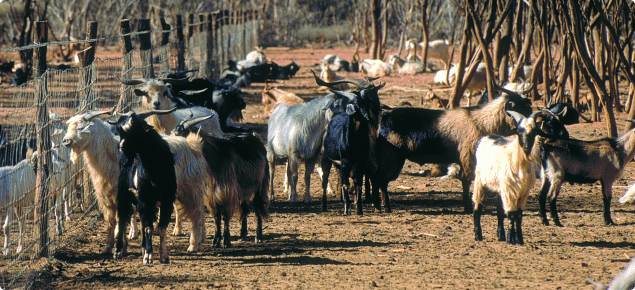
Rangeland goats behind a fence.
A DRAFT plan proposing the potential control of rangeland goats by baiting, aerial culling or dingoes has created concern in the commercial goat harvesting sector.
On November 3, the Albanese Government added feral goats in its war on invasive species, releasing a plan that recommends new goat control methods including the trial of new baits for feral goats and the use of drones and thermal cameras for aerial culling.
The ‘Draft threat abatement plan for competition and land degradation by unmanaged goats’ also recommends better data and monitoring to more efficiently direct control measures, and research into the impact of goats on the environment. It is designed to be flexible to support goat management in different jurisdictions and landscapes, considering differences in land systems and government policy frameworks.
Public consultation on the draft threat abatement plan is open until 7 February 2024. It can be read here: https://consult.dcceew.gov.au/draft-threat-abatement-plan-for-competition-and-land-degradation-by-unmanaged-goats
A release from the officer of Minister for the Environment and Water Tanya Plibersek said feral goats are found in every state and territory and are a threat to the survival of 128 threatened plant and animal species, including the brush-tailed rock wallaby and eleven species of wattle.
The release said important ecosystems in some of our most precious places like the Blue Mountains and the Great Barrier Reef World Heritage Area are damaged by feral goats and they have been found on at least 25 islands, disturbing bird nesting sites, overgrazing vegetation and creating severe erosion. In the Blue Mountains, feral goats graze on rock shelf vegetation and damage fragile cliff faces.
Feral goats also compete with native animals for food, carry disease and impose significant costs on Australian communities and farmers every year. It’s been estimated that there are over 5.8 million feral goats in New South Wales alone, the ministerial release said.
Capture rather than culling and poisoning
However, vice-president of the Pastoralists Association of West Darling and the Goat Industry Council’s rangeland representative Sam Beven said the abatement plan would be discussed at PAWD and GICA meetings in the next week.
However, he said there was concern about the abatement plan.
“Feral goats need to be controlled to stop them impacting land where sheep and cattle are being farmed, but just blindly shooting them seems a silly way to go.”
He said there needs to be attention given to growing potential goat meat markets like India to help prices back to an acceptable level.
“The feral goat numbers wouldn’t be a problem at all if we could sell them for a reasonable amount, and they wouldn’t be an invasive species because all the landholders would be mustering and dealing with them ourselves.”
He thought it would be more effective to put any intended monies intended for poisoning and shooting goats into incentivising their commercial harvesting or capture, or more marketing.
“I do think it would be a waste to just go killing them.”
Goats don’t belong in fragile places – Plibersek
Ms Plibersek said invasive species are one of the most serious threats to native plants and animals across Australia.
“Cats, horses, yellow crazy ants, and now goats – we have to deal with each of these threats to give our native species the best chance of survival,” she said.
“Goats don’t belong in fragile places like the Blue Mountains and the Great Barrier Reef islands.
“They compete with native species for food and shelter and water, while trampling over their critical habitats, causing erosion,” Ms Plibersek said.
“This plan is about better identifying and monitoring the threat, and taking action.
“It’s a huge step forward to protect 128 threatened species and the places they call home.”

What the ….!
Tanya should stick to her knitting. Rangelands goats are an economic resource, enabling Australia to be the largest exporter of the most-consumed red meat in the world. Feral pigs and horses are not.
Goats are browsers that seldom graze. The reason they’re often seen in overgrazed land, is because they’re the only animals that can survive there, after badly managed grazers have thrashed it.